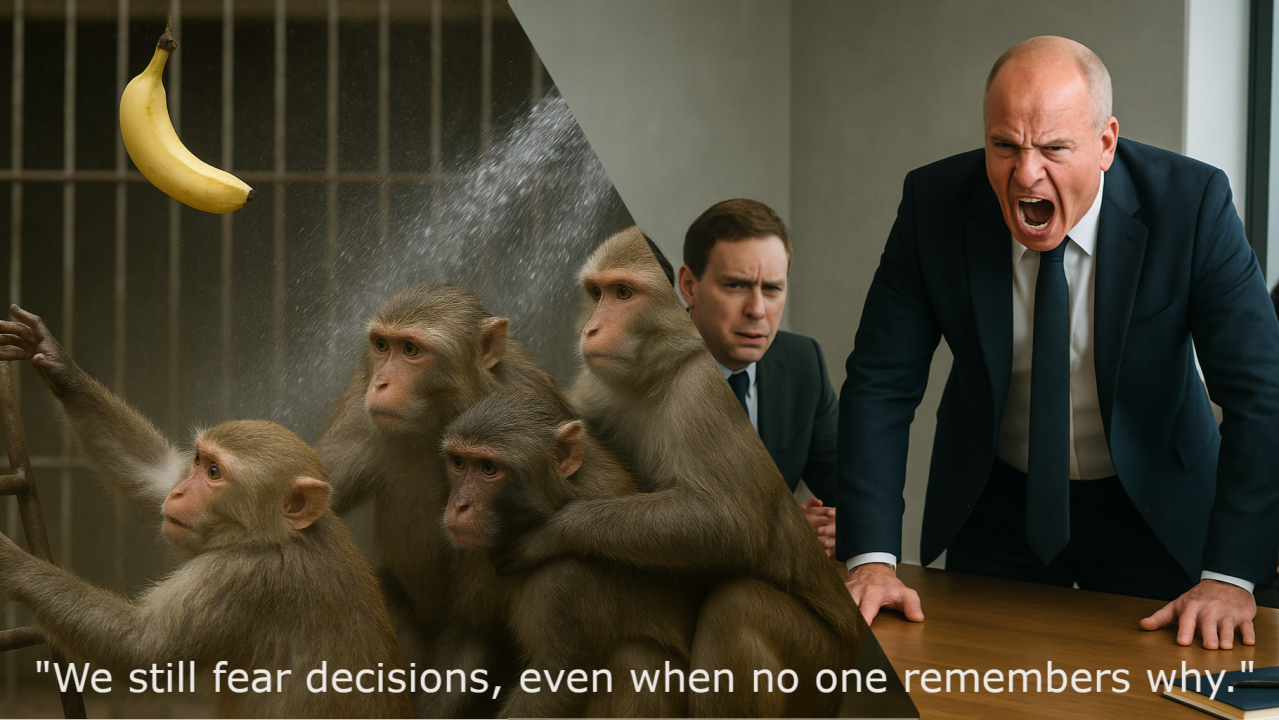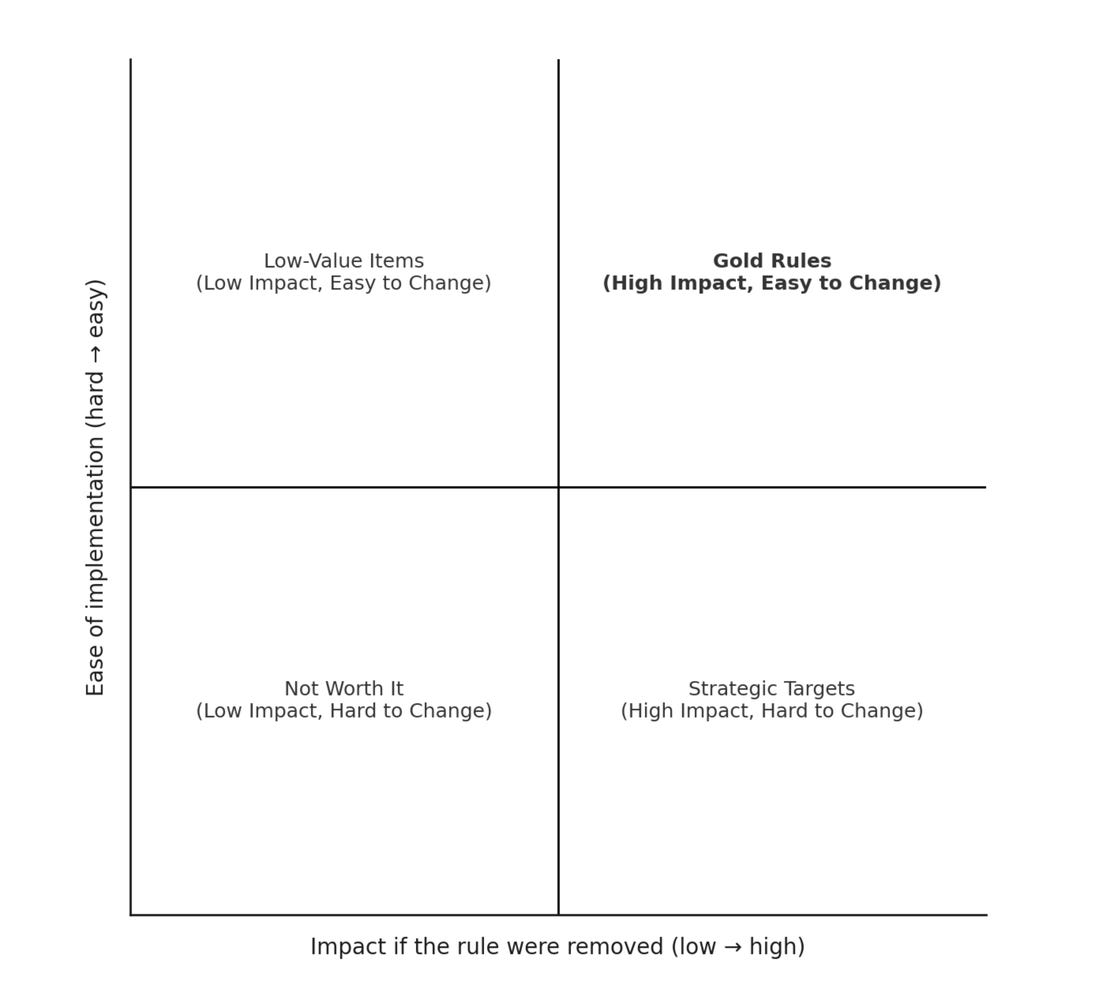We still fear decisions, even when no one remembers why
The "monkeys and bananas" myth and what it reveals about decision-making in organizations
Originally published on LinkedIn on 10.09.2025.
The parable
You´ve likely heard the story: five monkeys in a cage, a ladder and a banana. Each time a monkey climbs, the group gets sprayed with cold water. Soon, the monkeys police each other. Over time, every original monkey is replaced. None of the newcomers has ever experienced the cold water but, yet still, no one touches the banana. "That´s just how things are done here".
The truth behind the tale
As a literal experiment, this story never happened. Its roots trace back to a 1960s study by psychologist G.R. Stephenson, who used pairs of rhesus monkeys and air blasts, not bananas or ladders. Later retellings reshaped it into today´s parable. The fable survives because it illustrates something real: organizations often inherit behaviors and fears long after the original cause has vanished.
Why fear lingers in modern companies
Losses loom larger than gains. Humans overweight losses compared to equivalent gains (loss aversion1). In corporate contexts, "don´t get it wrong" often trumps "let´s try something bold".
The status quo feels safer. Faced with multiple options, people disproportionately pick the "do nothing" path (status quo bias2). That bias silently slows innovation.
Organizations remember even when people forget. Practices and norms outlive the people who created them. This "organizational memory3" ensures that outdated rules persist, even if the original risk is gone.
Small deviations become normal. Teams sometimes bend rules under pressure. If no crisis follows, those deviations harden into accepted practice, a process sociologists call "the normalization of deviance4".
Silence protects careers. Research on employee "voice5" shows how people self-censor in hierarchies. The risk of being wrong often outweighs the reward of speaking up. How often have you heard people say after a meeting: "I had the same thought, but I didn´t want to be the one to say it".
The cost of silence (and the upside of safety)
Team learning rises with psychological safety6. Harvard research shows that teams where members feel safe to take interpersonal risks learn faster and perform better.
Google confirmed it at scale. In "Project Aristotle", the single strongest predictor of team effectiveness was psychological safety (more than individual talent or experience).
Error-friendly cultures outperform. Studies of "error management7" show that treating mistakes as learning opportunities leads to higher adaptability, better performance and less stress.
How fear plays out in everyday meetings
A product review. A bold idea appears on slide 12.
Someone recalls a failed attempt years ago (none of the current team was involved). Another warns about "optics".
No one asks: "What would have to be true for this to work?" The idea dies quietly.
What was missing? Not data or talent, but a design for safety, candor and learning.
Ten plays for leaders to unlearn inherited fear
Classify decisions as reversible vs. irreversible. Most are reversible ("two-way doors8"). Treat them with speed and lightweight process.
Decide at ~70% information. Replace "prove it first" with "learn it fast".
Run premortems9. Ask: "It´s six months later and we failed, what happened?" This surfaces risks early.
Make postmortems10 blameless and mandatory. Focus on learning, not blame.
Teach error management. Practice handling mistakes constructively in simulations.
Create stop-the-line rights. Borrow from Toyota: anyone can halt work when quality or safety is at risk.
Measure psychological safety. Use short pulse surveys and discuss results openly.
Change meeting contracts. Begin with: "Dissent is contribution". Actively thank the first person who challenges the group.
Challenge the status quo. Ask: "Why now?" and "What would we learn?"
Archive decisions with reasons. Ensure future teams inherit context, not just cautious habits.
But how do you know if these plays are making a difference? Culture shifts are subtle and leaders often wonder whether progress is real or just wishful thinking.
How to know it´s working
Culture change doesn´t happen overnight. But there are signs that fear is losing its grip:
Decisions happen faster. Topics don´t circle endlessly in meetings; more "two-way doors" get tried quickly.
More voices are heard. You notice contributions from quieter team members and not just the usual few.
Experiments increase. Small pilots and tests become normal instead of rare exceptions.
Postmortems feel lighter. People focus on what was learned, not who was at fault.
Retention improves. Talented employees stay because they feel safe to grow and take risks.
If you start to see these patterns, it´s evidence that fear is no longer steering decisions, learning is.
Responsible use of the monkey story
The "monkeys and bananas" tale is a myth, but a useful metaphor. The real research did demonstrate how avoidance behaviors can spread socially, though under very different conditions. When retelling the fable, it´s wise to clarify its symbolic role and then pivot to evidence-backed practices.
Try this this week
Label one upcoming choice a "two-way door" and make it quickly.
Run a 20-minute premortem on your next project.
Pilot a blameless postmortem on any recent incident.
Add one pulse item to your retro: "On this team, it´s safe to take smart risks".
Bonus: Kill a Stupid Rule
I´ve personally had very positive experiences with a simple but powerful exercise: "Kill a Stupid Rule".
The method is described in Lisa Bodell´s book Kill the Company and is as straightforward as it is effective: Gather your team and ask one question:
"If you could kill one rule, process or guideline that slows us down or frustrates you, what would it be?"
At first, people hesitate. But once the first example is voiced (like a reporting routine no one reads or an approval step that adds no value) the floodgates open. Within minutes, the whiteboard fills with unnecessary rules, outdated practices, and "we´ve always done it this way" habits.
The magic lies in what happens next:
Teams feel relief that they can finally voice frustrations without fear.
Leaders discover hidden obstacles that were quietly draining energy.
By removing or simplifying just a handful of rules, the team gains a sense of empowerment and speed.
How to run the exercise
Set the stage. Clarify that the goal is not to criticize individuals but to identify outdated, frustrating or pointless rules and processes.
Ask the core question. Write it on a flipchart or whiteboard: "If you could kill one rule, process or guideline that slows us down or frustrates you, what would it be?"
Collect ideas. Give everyone sticky notes or use a digital board. Let people write down as many "rules" as they can think of (quietly at first, then share with the group).
Discuss and cluster. Group similar ideas together (e.g., "too many reports", "pointless approval steps", "ineffective metings").
Evaluate with the matrix. Draw a 2×2 grid (see below): X-axis: Impact if the rule were removed (low → high), Y-axis: Ease of implementation (hard → easy). Place the rules in the grid. Focus first on the "Gold Rules" in the top-right corner (easy to remove, big effect).
Act on quick wins. Choose 1–3 rules to kill or simplify immediately. The faster you show results, the more credibility the exercise gains.
Review and repeat. Revisit the list after a few months. Some rules may be gone, others may have emerged.
I´ve seen this exercise shift the mood of an entire group. Suddenly, people realize: many of the "cold showers" we fear are not real, they´re inherited, outdated or self-imposed.
"Kill a Stupid Rule" works because it´s practical, fast and collective. Instead of vague calls to "be innovative", it asks: What´s one thing we can stop doing tomorrow that makes us better?
Closing thought
Cultures don´t change by slogans like "be brave". They change when leaders redesign how decisions get made, how mistakes get handled and how voices get heard. Do that and the invisible cold shower loses its power.
Further Reading
G.R. Stephenson (1967), Cultural Acquisition of a Specific Learned Response Among Rhesus Monkeys
Kahneman & Tversky, Prospect Theory (1979)
Amy Edmondson, Psychological Safety and Learning Behavior in Work Teams (1999)
Google´s Project Aristotle (2016)
Diane Vaughan, The Challenger Launch Decision (1996)
Michael Frese & N. Keith, Action errors, error management, and learning in organizations (2015)
Loss Aversion: The tendency to feel losses more strongly than equivalent gains. Example: Losing 100,00 € hurts more than winning 100,00 € feels good.
Status Quo Bias: A preference for sticking with the current state of affairs, even when alternatives might be better.
Organizational Memory: The "memory" of an organization: routines, rules and practices that persist long after the original reasons are forgotten.
Normalization of Deviance: When small rule violations become tolerated because "nothing bad happened", eventually turning into the new normal.
Employee Voice (or simply "Voice"): A term for employees´ willingness to speak up with concerns or ideas or to stay silent.
Psychological Safety: A shared belief that it´s safe to take interpersonal risks on a team (asking questions, admitting mistakes or trying new things) without fear of negative consequences.
Error Management Culture: An organizational culture that treats mistakes as learning opportunities rather than punishable offenses.
Two-Way Door Decision: A decision-making model (popularized at Amazon): some decisions are reversible ("two-way doors") and can be made quickly, while others are irreversible and require more caution.
Premortem: A planning exercise before starting a project: the team imagines the project has failed and discusses why. This helps surface risks early.
Postmortem (or Retrospective): A structured review after a project or incident to analyze what went well and what should improve, ideally blamelessly.




